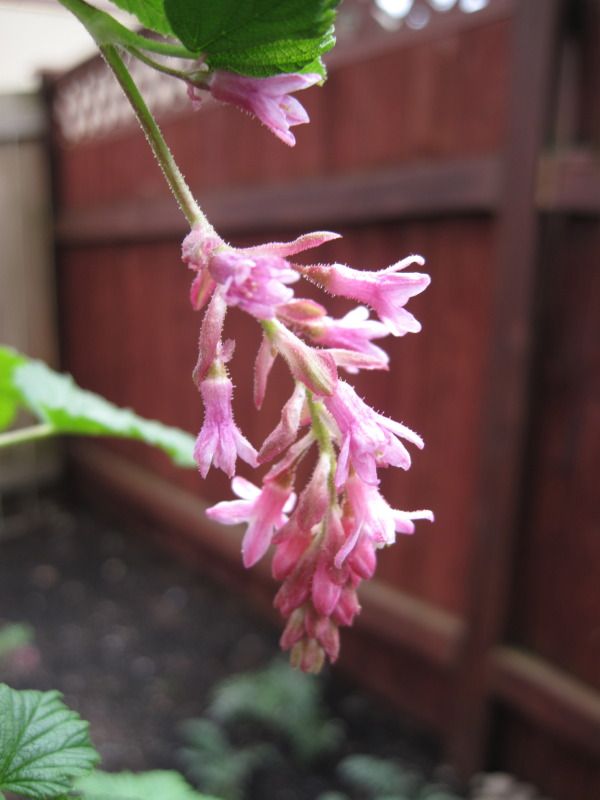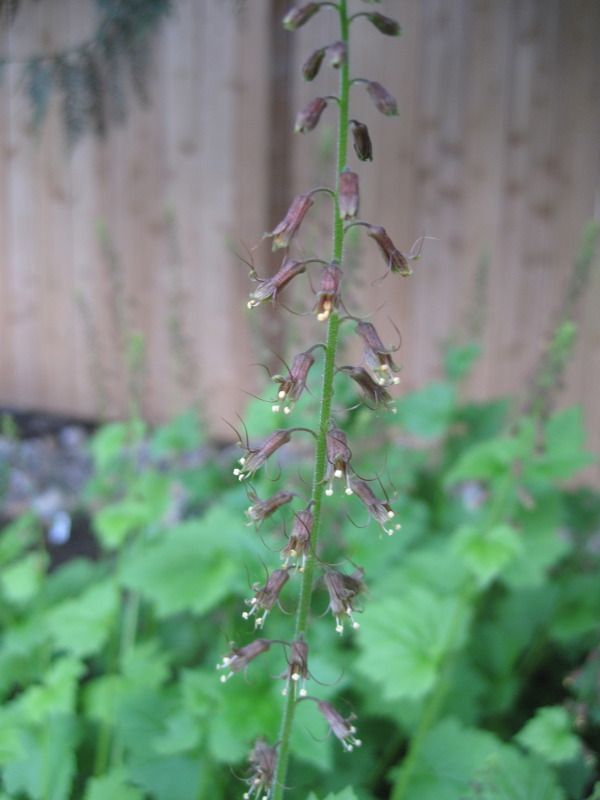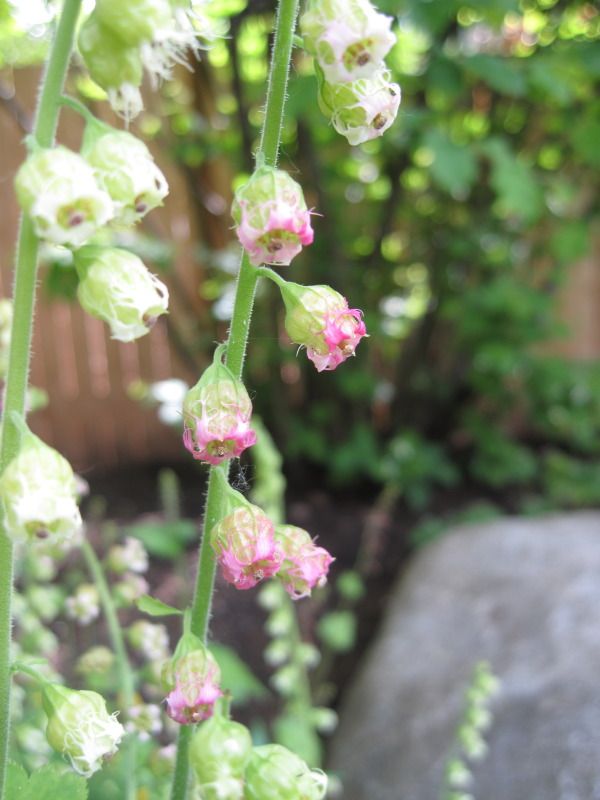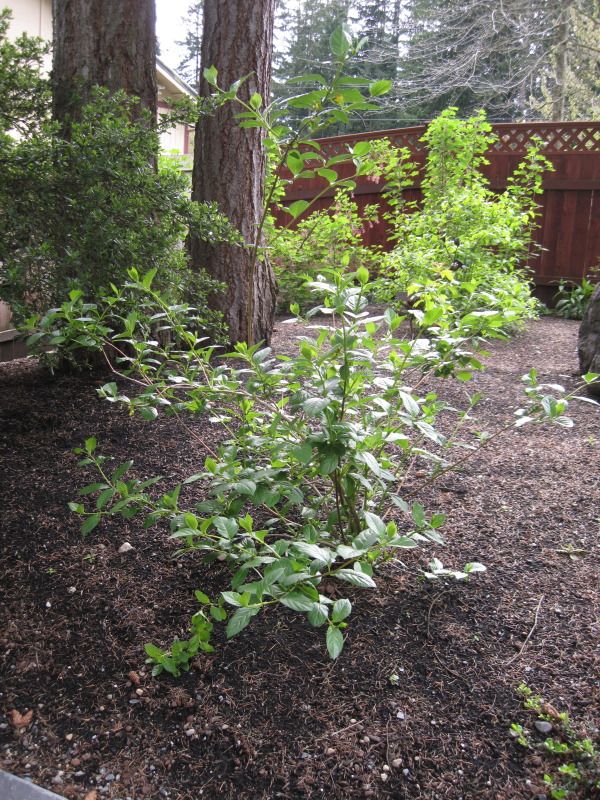If you've been reading my blog for a while, you know I have a lot of
Pacific Northwest native plants. The very first year I had my new garden, I started by learning about, and then filling it, with native shrubs and perennials. I bought lots of shrubs from the Pierce Conservation District's spring sale, and although they all started off small and bare root, they have mostly thrived and grown huge. They were inexpensive, too. Then a couple of months later, I bought perennials and a few more shrubs at the Washington Native Plant Society's Spring sale, which is coming up again on May 12, from 10-4 at the Bellevue Botanical Garden.
I love growing natives in my garden, for many reasons. Many of them, the shrubs especially, have been completely care-free. I stuck them in the soil that first spring, and gave them little supplemental water or fertilizer (other than the compost-rich soil they were first planted in). You'll see from my pictures how well they have done. Many Washington native plants are well-adapted to our weather cycle of rain, followed by summer drought, followed by rain. Another reason why I love planting natives is that they are wildlife-friendly, often providing shelter and food, in the form of berries, to birds.
I recently found out that Washington Governor Christine Gregoire has declared the week from April 29 to May 5 to be Native Plant Appreciation Week.
From the Washington Native Plant Society's web page: "This week is a celebration of the amazing diversity of Washington’s over
3000 native plant species that inhabit deserts, rain forests, high
alpine environments, river valleys, and even backyard landscapes.
Native plant ecosystems are critical to sustaining our native wildlife
and the quality of Washington’s environment."
So I thought to celebrate Native Plant Appreciation Week, I'd show some pictures of the native
plants growing in my garden, to illustrate how they look, their growth habit, etc. And maybe tell you a little something about them, and how they're doing in my garden.
 |
| Trillium ovatum, our native PNW Trillium |
There are many Trilliums that are native to North America, and I have several different ones growing in the woodland area of my garden. Trillium ovatum is the one that is native to the PNW. One of the coolest things about our native Trillium is that the blooms start out white, and then turn pink as they mature. I planted these around this time last year, and I'm thrilled that they have returned. I hope they continue to thrive.
 |
| White Dodecatheon hendersonii |
 |
| Purple Dodecatheon hendersonii |
As you can see from the pictures, I have two kinds of Dodecatheon hendersonii growing in my garden -- white and purple. The purple flowered earlier than the white, it's done now. But the white are flowering fully right now. This is another wildflower that I just added last year, and I am so happy to see it has come back even bigger than last year. A couple of common names for this flower are shooting star, and mosquito bills. I like calling it shooting star better, don't you? I love the way all the flowers hang off the central stalk, like a chandelier. Like many PNW natives, it prefers a dry summer period. According to what I've read online, it forms colonies. I'm keeping my fingers crossed.
 |
| Dicentra formosa |
I have lots of happy clumps of Dicentra formosa growing in my garden. This is our native Pacific bleeding heart. I've always had a soft spot for bleeding hearts of all kinds. In fact, I have several large specimens of Dicentra spectabilis 'Gold Heart' (I know they gave it a new name, but
feh!) I'll have to show photos of that another time.
 |
| White Dicentra formosa |
I have this native in both pink and white. After the flowers are pollinated (I hear hummers like it, but I haven't seen any near it), a little bean-like seedpod forms, which ripens and splits and spills tiny black seeds with a white bit of fat, called an elaiosome, that attracts ants, who carry the seeds into their colonies to feed the elaiosome to their larvae, and then discard the seed itself. Despite its delicate appearance, with its airy fern-like foliage, it is a very hardy colonizer.
 |
| Amelanchier alnifolia |
 |
| Amelanchier alnifolia flower cluster |
Amelanchier alnifolia, or serviceberry, is quite widespread across the
western half of North America. It was one of the first shrubs I planted
in my back garden, and this is the first time it has flowered. It is
much taller than it was when it was first planted, so it must be quite
happy where it is. It seems to be developing a central leader, which I
have read it has a tendency to do in rich soil. It can grow up to 18
feet tall. I planted it originally for the wildlife, but if it
develops berries, I may give them a taste myself. They are edible, and
have been made into pies and muffins, as well as wine. I'm hoping it's
not the kind of berry that needs a second pollinator nearby, because I
only have one. I seem to recall it had good fall color too.
 |
| Sambucus racemosa |
 |
| Sambucus racemosa flower cluster |
Sambucus racemosa is the native PNW red elderberry. These were also
planted about two years ago, and at the time they were little more than
sticks with roots. They've grown well, and are flowering right now for
the first time. I see them everywhere at the side of the road as well as
here in my own garden. There are elderberry cultivars with dark leaves
that have been introduced recently to gardeners, but those are based on
Sambucus nigra, or black elderberry, rather than red elderberry, which
can get quite large and rangy, with fast-growing suckers. That makes them a great option to fill space quickly. Also red
elderberries are reputedly poisonous, whereas black elderberries can be
cooked and made into preserves and wine. But both attract birds and
other wildlife.
 |
| Ribes sanguineum |
 |
| Ribes sanguineum |
Ribes sanguineum, or red-flowering currant, also grows profusely in my garden. I love this flower! At the moment, it is still blooming, but the flowers are just past their prime. They say it attracts hummers, but I haven't seen any yet. I planted these as mere sticks with roots two years ago, and they have flourished. Several cultivars of this shrub are on the market, including one with white flowers. But my experience with the species has been wonderful. I love the somewhat maple-y shape of their leaves too.
 |
| Tolmieia menziesii |
 |
| Close-up of the Tolmieia flower |
Tolmiea menziesii, aka Piggyback plant or mother of thousands, is another Washington native perennial that I have growing in my garden. This interesting plant has tiny plantlets that grow on the ends of the stems, which weigh down the stem to the ground and take root, leaving behind baby plants for next year. The one pictured above died out this past winter, but left behind its babies.
 |
| Piggyback plant babies |
It has been sold as a house plant in the past. I have a variegated one as well, but like many variegated plants, it is not quite as vigorous. This plant is named after two explorers of the Pacific Northwest -- William Fraser Tolmie, a fur trader who was the first European to explore the Puyallup River valley and Mount Rainier on a botanizing trip; and Archibald Menzies, a botanist who sailed with Captain George Vancouver on his ship Discovery.
 |
| Large swath of Tellima grandiflora |
 |
| Mature Tellima flowers turn pink |
 |
| Baby Tellima plants cover the soil in the woodland area. |
Tellima grandiflora looks a lot like a Heuchera, until it flowers. Its flowers tower over the plant in nodding spires, start out yellow and slowly turn pink as they age. They are fringed, which is why the common name of this plant is Fringecups. It self-sows prolifically. I started with only a few a couple of years ago, and now they are everywhere. But they are shallow-rooted and quite easy to pull out.
 |
| Unfurling sword fern fronds |
Polystichum munitum, the ubiquitous Pacific Northwest sword fern, is a workhorse in my garden. I have them growing in almost every bed. I see them in wild places, at the roadside, growing huge, looking primeval. Like Hellebores, they produce new leaves in late winter or early spring, and need to have their old ratty fronds cut back. Once established, they are very tolerant of our summer drought, and can take our weak summer sun.
 |
| Lonicera involucrata |
 |
| Twinberry flowers |
Lonicera involucrata, aka twinberry, is a shrubby native honeysuckle that also started out in my garden as slender sticks with roots. It produces little yellow flowers in pairs close together, which eventually turn into a double black berry -- hence the common name. The bracts around the berries turn bright red as the berries mature. They are tolerant of our summer drought once established. I lost one shrub the first year because I planted it in an out-of-the-way bed, and it rarely got watered.
 |
| Acer circinatum |
 |
| Acer circinatum |
I miss the sugar maples from New England, with their wonderful rich fall color. Maples are probably my favorite tree (but ask on another day and the answer might change). Vine maple, Acer circinatum, is a Washington native maple that stays small. Not actually a vine, it does have a thin trunk that sprawls or leans. It is a common understory tree in our dense woodsy areas, under Douglas firs. Many have trunks that are reddish, and have given rise to cultivars with names like 'Pacific Fire.' In my opinion, some of these cultivars rival Japanese maples, in fact, I have sometimes mistaken them for Japanese maples at the nursery (not that fooling me is all that difficult).
 |
| Physocarpus capitatus |
 |
| One of last year's ninebark flower clusters -- it's too early for it to flower now. |
Like the many ninebark varieties that have been appearing at the nursery with gold and purple leaves, Pacific ninebark, Physocarpus capitatus, has exfoliating bark, clusters of tiny flowers, and wide maple-like leaves. However, all those wonderful new cultivars with interesting leaf colors come from Physocarpus opulifolius, the east coast native ninebark. I have three or four Pacific Ninebark growing in my garden, and they are all thriving as well, with little care.
 |
| Oemleria cerasiformis flower |
Oemleria cerasiformis is also called Indian plum or Oso Berry. It is one of the first native understory trees to flower in the early spring or late winter. Male and female flowers grow on separate plants, and you need one of each in proximity to produce fruit. But even without fruit, the flowers are such a welcome sight so early. Its "plums" are actually purple berries about the size of olives. Its flowers are said to have a bad cat pee-like smell, but only if you put your nose right into them. According to all the info I've found online, it is pest and disease free, which has definitely been my experience. It got watered well its first year, but since then has received no special care. I've seen this small tree in flower at the side of the road in early spring, and the flowers almost literally twinkle.
I could go on and on with yet more information about Washington natives that I have growing in my garden, but I think maybe I've covered enough ground. I have quite a few more, especially bulbs, that I will cover at a late date, when they start flowering.
My garden also has plenty of other plants that are native to North America, or to just Oregon and northern California. I'll save them for another time as well.
Phew! I've been working on this post all week -- taking photos and sifting through old ones from previous years -- and I finally finished, just in time. From the Trillium to the towering Douglas firs, I love the natives in my garden! I hope you've found some useful information here, and if you garden in the PNW, please consider growing more of these great plants!
*********************
To learn more about landscaping with native plants from the Pacific Northwest, click
here.

























